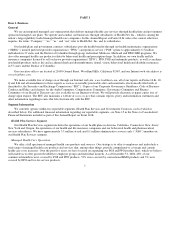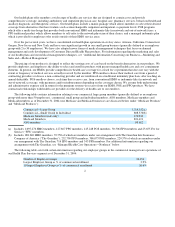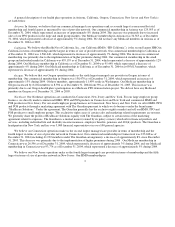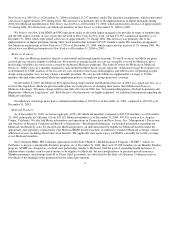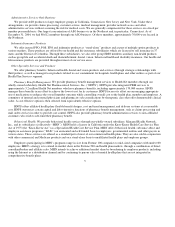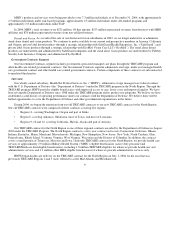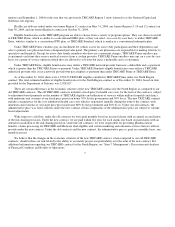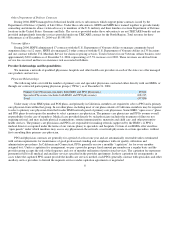Health Net 2004 Annual Report Download - page 14
Download and view the complete annual report
Please find page 14 of the 2004 Health Net annual report below. You can navigate through the pages in the report by either clicking on the pages listed below, or by using the keyword search tool below to find specific information within the annual report.
We then provide information directly to employees once the employer has selected our health coverage. Finally, we engage members
and employers in marketing for member and group retention. Although we market our products and services primarily through
independent brokers, agents and consultants, we use our limited internal sales staff to serve certain large employer groups. Once
selected by a large employer group, we solicit enrollees from the employee base directly. During “open enrollment” periods when
employees are permitted to change health care programs, we use a variety of techniques to attract new enrollees, including, without
limitation, direct mail, work day and health fair presentations and telemarketing. Our sales efforts are supported by our marketing
division, which engages in product research and development, multicultural marketing, advertising and communications, and member
education and retention programs.
Premiums for each employer group are generally contracted on a yearly basis and are payable monthly. We consider numerous
factors in setting our monthly premiums, including employer group needs and anticipated health care utilization rates as forecasted by
us based on the demographic composition of, and our prior experience in, our service areas. Premiums are also affected by applicable
regulations that prohibit experience rating of group accounts (i.e., setting the premium for the group based on its past use of health
care services) and by state regulations governing the manner in which premiums are structured.
We believe that the importance of the ultimate health care consumer (or member) in the health care product purchasing process
is likely to increase in the future, particularly in light of advances in technology and online resources. Accordingly, we intend to focus
our marketing strategies on the development of distinct brand identities and innovative product service offerings that will appeal to
potential health plan members. For example, in 2004, we introduced Decision Power
SM
, which is a series of programs designed to
more directly involve patients in their health care decisions. These programs allow our members to access information and consult
with health coaches as they are making decisions regarding health care issues. We first introduced Decision Power
SM
to a select group
of health plan participants in January 2004 and, in 2005, are expanding access to Decision Power
SM
to a broader range of our health
plan members. Based on feedback received from health plan members who have participated in the Decision Power
SM
programs, we
believe Decision Power
SM
is being met favorably throughout our service areas. We believe that Decision Power
SM
could be a
meaningful competitive differentiator for our health plans in the future.
Health Net One Systems Consolidation Project
We are in the process of converting a number of information systems in our health plan business to a single system environment.
At the completion of the project, we will consolidate various systems into one general ledger system, one core claims system, one
data warehouse system and one core web system. In addition, we will reduce our number of surround information systems to 16 and
consolidate our data centers to a single site with a tested backup facility. Key actions completed on the Health Net One systems
consolidation project to date include consolidation to a single general ledger, consolidation of health plan portals, consolidation of
data centers to a single site with backup facilities, consolidation of surround information systems and conversion of Arizona’s core
claims system. In late 2003, we converted to a common eligibility database and in 2004 we converted to a common provider database.
In order to increase our focus on market demands, revenue generation and cost-containment initiatives and to ensure the continued
stabilization of claim payment patterns, we have decided to change the sequence of the Health Net One initiatives, placing the
medical management initiatives and developing market capabilities ahead of the claim components of Health Net One. As a result, the
conversion of the California and Oregon claims systems have been rescheduled for 2006. We believe that completion of the Health
Net One systems consolidation project will improve customer/client service and communication, national product capabilities realize
operational and cost efficiencies and improve our decision making capability. In addition, we believe that completion of the project
will enable us to improve our claims turnaround time, auto adjudication rates, electronic data interchange and Internet capabilities.
However, there are risks associated with the Health Net One systems consolidation project. See “Risk Factors—The failure to
effectively maintain our management information systems could adversely affect our business.”
11


